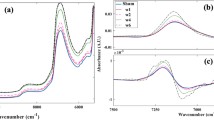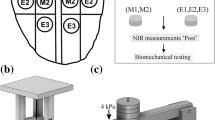Abstract
Many attempts have been made to estimate the post-mortem interval (PMI) using bioanalytical methods based on multiple biological samples. Cartilage tissues could be used as an alternative for this purpose because their rate of degradation is slower than that of other soft tissue or biofluid samples. In this study, we applied Fourier transform infrared (FTIR) spectroscopy to acquire bioinformation from human annular cartilages within 30 days post-mortem. Principal component analysis (PCA) showed that sex and causes of death have almost no impact on the overall spectral variations caused by post-mortem changes. With pre-processing approaches, several predicted models were established using a conventional machine learning method, known as the partial least square (PLS) regression. The best model achieved a satisfactory prediction with a low error of 1.49 days using the second derivative transform of 3-point smoothing and extended multiplicative scatter correction (EMSC), and the spectral regions from proteins and carbohydrates contributed greatly to the PMI prediction. This study demonstrates the feasibility of cartilage-based FTIR analysis for PMI estimation. Further work will introduce advanced algorithms for more accurate and precise PMI prediction.




Similar content being viewed by others
References
Jellinghaus K, Hachmann C, Holand K, Bohnert M, Wittwer-Backofen U. Collagen degradation as a possibility to determine the post-mortem interval (PMI) of animal bones: a validation study referring to an original study of Boaks et al. (2014). Int J Legal Med. 2018;132:753–63.
Amadasi A, Cappella A, Cattaneo C, Cofrancesco P, Cucca L, Merli D, et al. Determination of the post mortem interval in skeletal remains by the comparative use of different physico-chemical methods: are they reliable as an alternative to (14)C? Homo. 2017;68:213–21.
Gelderman HT, Boer L, Naujocks T, IJzermans ACM, Duijst WLJM. The development of a post-mortem interval estimation for human remains found on land in the Netherlands. Int J Legal Med. 2018;132:863–73.
Swain R, Kumar A, Sahoo J, Lakshmy R, Gupta SK, Bhardwaj DN, et al. Estimation of post-mortem interval: a comparison between cerebrospinal fluid and vitreous humour chemistry. J Forensic Legal Med. 2015;36:144–8.
Li C, Wang Q, Zhang Y, Lin H, Zhang J, Huang P, et al. Research progress in the estimation of the postmortem interval by Chinese forensic scholars. Forensic Sci Res. 2016;1:3–13.
Zhang J, Li B, Wang Q, Li C, Zhang Y, Lin H, et al. Characterization of postmortem biochemical changes in rabbit plasma using ATR-FTIR combined with chemometrics: a preliminary study. Spectrochim Acta A Mol Biomol Spectrosc. 2017;173:733–9.
Zhang J, Li B, Wang Q, Wei X, Feng W, Chen Y, et al. Application of Fourier transform infrared spectroscopy with chemometrics on postmortem interval estimation based on pericardial fluids. Sci Rep. 2017;7:18013.
Zhang J, Wei X, Huang J, Lin H, Deng K, Li Z, et al. Attenuated total reflectance Fourier transform infrared (ATR-FTIR) spectral prediction of postmortem interval from vitreous humor samples. Anal Bioanal Chem. 2018;410:7611–20.
Johnson LA, Ferris JA. Analysis of postmortem DNA degradation by single-cell gel electrophoresis. Forensic Sci Int. 2002;126:43–7.
Pittner S, Ehrenfellner B, Monticelli FC, Zissler A, Sänger AM, Stoiber W, et al. Postmortem muscle protein degradation in humans as a tool for PMI delimitation. Int J Legal Med. 2016;130:1547–55.
Hands JR, Clemens G, Stables R, Ashton K, Brodbelt A, Davis C, et al. Brain tumour differentiation: rapid stratified serum diagnostics via attenuated total reflection Fourier-transform infrared spectroscopy. J Neuro-Oncol. 2016;127:463–72.
Kumar S, Desmedt C, Larsimont D, Sotiriou C, Goormaghtigh E. Change in the microenvironment of breast cancer studied by FTIR imaging. Analyst. 2013;138:4058–65.
Thumanu K, Sangrajrang S, Khuhaprema T, Kalalak A, Tanthanuch W, Pongpiachan S, et al. Diagnosis of liver cancer from blood sera using FTIR microspectroscopy: a preliminary study. J Biophotonics. 2014;7:222–31.
Li Q, Hao C, Kang X, Zhang J, Sun X, Wang W, et al. Colorectal cancer and colitis diagnosis using Fourier transform infrared spectroscopy and an improved K-nearest-neighbour classifier. Sensors. 2017;17:2739.
Galindo-Prieto B, Eriksson L, Trygg J. Variable influence on projection (VIP) for orthogonal projections to latent structures (OPLS). J Chemom. 2014;28:623–32.
Valderrama P, Braga JW, Poppi RJ. Variable selection, outlier detection, and figures of merit estimation in a partial least-squares regression multivariate calibration model. A case study for the determination of quality parameters in the alcohol industry by near-infrared spectroscopy. J Agric Food Chem. 2007;55:8331–8.
Claassen H, Werner J. Gender-specific distribution of glycosaminoglycans during cartilage mineralization of human thyroid cartilage. J Anat. 2004;205:371–80.
Riaz T, Zeeshan R, Zarif F, Ilyas K, Muhammad N, Safi SZ, et al. FTIR analysis of natural and synthetic collagen. Appl Spectrosc Rev. 2018;53:703–46.
Camacho NP, West P, Torzilli PA, Mendelsohn R. FTIR microscopic imaging of collagen and proteoglycan in bovine cartilage. Biopolymers. 2001;62:1–8.
Susi H, Byler DM. Protein structure by Fourier transform infrared spectroscopy: second derivative spectra. Biochem Biophys Res Commun. 1983;115:391–7.
Genkawa T, Ahamed T, Noguchi R, Takigawa T, Ozaki Y. Simple and rapid determination of free fatty acids in brown rice by FTIR spectroscopy in conjunction with a second-derivative treatment. Food Chem. 2016;191:7–11.
Windig W. The use of second-derivative spectra for pure-variable based self-modeling mixture analysis techniques. Chemom Intell Lab Syst. 1994;23:71–86.
Martens H, Bruun SW, Adt I, Sockalingum GD, Kohler A. Pre-processing in biochemometrics: correction for path-length and temperature effects of water in FTIR bio-spectroscopy by EMSC. J Chemom. 2006;20:402–17.
Kohler A, Sule-Suso J, Sockalingum GD, Tobin M, Bahrami F, Yang Y, et al. Estimating and correcting Mie scattering in synchrotron-based microscopic fourier transform infrared spectra by extended multiplicative signal correction. Appl Spectrosc. 2008;62:259–66.
Kohler A, Böcker U, Warringer J, Blomberg A, Omholt SW, Stark E, et al. Reducing inter-replicate variation in fourier transform infrared spectroscopy by extended multiplicative signal correction. Appl Spectrosc. 2009;63:296–305.
Rogers CJ, Clark K, Hodson BJ, Whitehead MP, Sutton R, Schmerer WM. Postmortem degradation of porcine articular cartilage. J Forensic Legal Med. 2011;18:52–6.
Alibegović A. Cartilage: a new parameter for the determination of the postmortem interval? J Forensic Legal Med. 2014;27:39–45.
Hicks DL, Sage AB, Schumacher BL, Jadin KD, Agustin RM, Sah RL, et al. Stored human septal chondrocyte viability analyzed by confocal microscopy. Arch Otolaryngol Head Neck Surg. 2006;132:1137–42.
Lasczkowski GE, Aigner T, Gamerdinger U, Weiler G, Bratzke H. Visualization of postmortem chondrocyte damage by vital staining and confocal laser scanning 3D microscopy. J Forensic Sci. 2002;47:663–6.
Bolton SN, Whitehead MP, Dudhia J, Baldwin TC, Sutton R. Investigating the postmortem molecular biology of cartilage and its potential forensic applications. J Forensic Sci. 2015;60:1061–7.
Funding
This study is supported by grants from the National Natural Science Foundation of China (81801873, 81730056, 81722027, 81601645 and 81671869), the National Key R&D Program of China (2016YFC0800702), and the Science and Technolo gy Committee of Shanghai Municipality (17DZ2273200 and 19DZ2292700).
Author information
Authors and Affiliations
Corresponding authors
Ethics declarations
Conflict of interest
All authors declare that they have no conflict of interest.
Ethical approval
This study was conducted with the approval of the ethics committee of the Institute of Forensic Sciences, Ministry of Justice, P.R. China.
Informed consent
Work involving the use of human specimens was performed after informed written consent was obtained from family members of the victims.
Additional information
Publisher’s note
Springer Nature remains neutral with regard to jurisdictional claims in published maps and institutional affiliations.
Rights and permissions
About this article
Cite this article
Li, Z., Huang, J., Wang, Z. et al. An investigation on annular cartilage samples for post-mortem interval estimation using Fourier transform infrared spectroscopy. Forensic Sci Med Pathol 15, 521–527 (2019). https://doi.org/10.1007/s12024-019-00146-x
Accepted:
Published:
Issue Date:
DOI: https://doi.org/10.1007/s12024-019-00146-x




